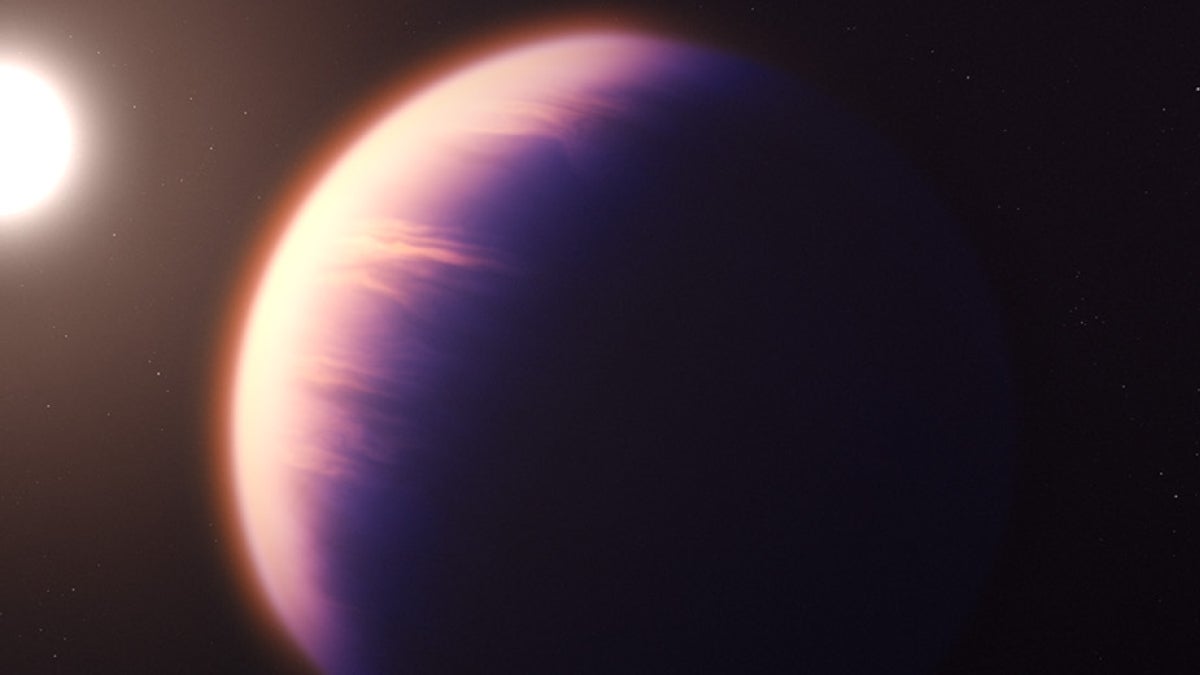Carbon dioxide observed in exoplanet atmosphere by James Webb Space Telescope

A team of planetary scientists, including Arizona State University Associate Professor Michael Line, have detected carbon dioxide in the atmosphere of a gas giant exoplanet with the James Webb Space Telescope (JWST).
The discovery demonstrates the long-awaited capabilities of JWST to observe the atmospheres of planets outside our solar system, revealing their composition and formation histories. These results open the door to the possibility of learning about the composition of smaller rocky planets that are thought to also have carbon dioxide in their atmospheres.
The results of their findings have been accepted in Nature, titled “Identification of Carbon Dioxide in an Exoplanet Atmosphere.” This is the first accepted publication detailing exoplanet observations with JWST.
The gas giant exoplanet WASP-39 b was discovered in 2011 and orbits a star similar to our sun but 700 light years away. It has a mass approximately that of Saturn and it takes only four days to complete one orbit of its star, making it extremely hot, about 1,400 degrees Celsius. WASP-39b and other transiting exoplanets will allow researchers to examine the atmospheres of these worlds. A transit is when a planet passes between a star and the observer causing a slight dimming of the starlight.
For the study, Line, who is an associate professor in the School of Earth and Space Exploration, and the team used JWST’s Near-Infrared Spectrograph (NIRSpec) to make the observations of the planet in different wavelengths, or colors, of light as it passed in front of its host star. These observations, also known as a transit spectrum, allowed the team of researchers to determine exactly what the planet’s atmosphere is made of.
A transmission spectrum of the hot gas giant exoplanet WASP-39 b captured by Webb’s Near-Infrared Spectrograph (NIRSpec) on July 10 reveals the first definitive evidence for carbon dioxide in a planet outside the solar system. This is the first detailed transmission spectrum ever captured that covers wavelengths between 3 and 5.5 microns. Chart courtesy NASA, ESA, CSA, Leah Hustak (STScI), Joseph Olmsted (STScI)
“I felt like a kid in a candy store when I first saw this spectrum. The fact that we can see unambiguous bumps and wiggles – point to them and say, 'Hey, that’s carbon dioxide, hey, that’s water vapor, whoa, here’s this other bump and I don’t know what it is!' — suggests enormous potential for discovery in the worlds beyond our solar system. It truly is a game changer,” Line said.
Understanding the composition of a planet’s atmosphere is important because it tells us something about the origin of the planet and how it evolved.
“Carbon dioxide molecules are sensitive tracers of the story of planet formation,” Line said. “By measuring this carbon dioxide feature, we can determine how much solid (carbon and oxygen rich ices) versus how much gaseous (hydrogen and helium) material was used to form this gas giant planet. In the coming decade, JWST will make this measurement for a variety of planets, providing insight into the details of how planets form and the uniqueness of our own solar system.”
The NIRSpec prism observation of WASP-39 b is just one part of a larger investigation that includes observations of this planet using multiple instruments on board JWST, as well as observations of two other transiting planets. The investigation, which is part of the Early Release Science program, was designed to provide the exoplanet research community with robust JWST data as soon as possible.
“The goal is to analyze the Early Release Science observations quickly and develop open-source tools for the science community to use,” said Vivien Parmentier of Oxford University, co-author of the study. “This enables contributions from all over the world and ensures that the best possible science will come out of the coming decades of observations.”
Line, along with NASA Hubble Postdoctoral Fellow Luis Welbanks and graduate student Lindsey Wiser, both in the School of Earth and Space Exploration, are leading the theoretical interpretations of the data arising from the Early Release Science program.
“This is a once in a lifetime opportunity,” Welbanks said. “For the first time in the history of the field, hundreds of people around the world are working together to learn as much as we can from these precious observations.”
“This is just the beginning. We have many more datasets to analyze from this program — and several others — over the next months and years,” Line said. “I’m still trying to process in my head that we are finally obtaining data from JWST. I thought I would have seen this data as a graduate student a decade ago. The wait was worth it."
Top image: Illustration showing what exoplanet WASP-39b could look like, based on current understanding of the planet. Courtesy NASA, ESA, CSA, Joseph Olmsted (STScI)
More Science and technology

ASU postdoctoral researcher leads initiative to support graduate student mental health
Olivia Davis had firsthand experience with anxiety and OCD before she entered grad school. Then, during the pandemic and as a result of the growing pressures of the graduate school environment, she…

ASU graduate student researching interplay between family dynamics, ADHD
The symptoms of attention deficit hyperactivity disorder (ADHD) — which include daydreaming, making careless mistakes or taking risks, having a hard time resisting temptation, difficulty getting…

Will this antibiotic work? ASU scientists develop rapid bacterial tests
Bacteria multiply at an astonishing rate, sometimes doubling in number in under four minutes. Imagine a doctor faced with a patient showing severe signs of infection. As they sift through test…
